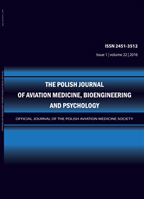2023, Volume 29, Issue 2
LOWER BODY NEGATIVE PRESSURE AS A SIMULATION METHOD FOR +Gz ACCELERATION STRESS: A FEASIBILITY AND COMPARATIVE ANALYSIS
RAFAŁ LEWKOWICZ1, PAULINA BARAN2, MARIUSZ KREJ2, MIROSŁAW DEREŃ2, ŁUKASZ DZIUDA2
-------------------------------------------------------------------------------------------------
1Simulator Study and Aeromedical Training Division, Military Institute of Aviation Medicine
2Department of Psychophysiological Measurements and Human Factor Research, Military Institute of Aviation Medicine
Autor korenspondencyjny: RAFAŁ LEWKOWICZ; Simulator Study and Aeromedical Training Division, Military Institute of Aviation Medicine; email: rlewkowicz@wiml.waw.pl
Full text
Streszczenie
Introduction: This paper explores the utility of Lower Body Negative Pressure (LBNP) as a simulation method for replicating the physiological effects of +Gz acceleration stress experienced by aviators during high-performance flight maneuvers.
The study investigates the feasibility of using LBNP to induce cardiovascular responses akin to those observed during +Gz acceleration, including changes in heart rate, blood pressure, stroke volume, cardiac output, mean arterial pressure, and central venous pressure.
Methods: Through a comprehensive review of existing literature and empirical data (keywords and filters such as LBNP, aerospace, centrifuge, simulator, acceleration, Gz, and databases including PubMed, IEEE Xplore, ScienceDirect, and others relevant to this field of study were selected for the search), we evaluate the efficacy of LBNP in simulating the hemodynamic challenges associated with high-G environments.
Results: The results of the review were organized by thematic categories (advantages of the LBNP test compared to a human centrifuge, changes in heart rates during exposure to +Gz and in the LBNP test, and the relationship between tolerance to LBNP and G-tolerance level). Syntheses of the results are presented, highlighting key themes and insights.
Discussion and Conclusion: LBNP appears to be effective in simulating the impact of +Gz acceleration, particularly in conditions where the acceleration changes slowly (0.01 G/s) or moderately (0.05 G/s). Our findings suggest that LBNP holds promise as a versatile and practical tool for investigating physiological responses to +Gz acceleration stress and for advancing our understanding of human adaptation to extreme gravitational forces. Considering the high cost of installing a human centrifuge to assess +Gz acceleration tolerance, LBNP may serve as a cost-effective alternative for studying human physiology during exposure to moderate and slowly varying acceleration (+Gz).
Słowa kluczowe
aviation medicine, LBNP, negative pressure, acceleration stress, centrifuge
